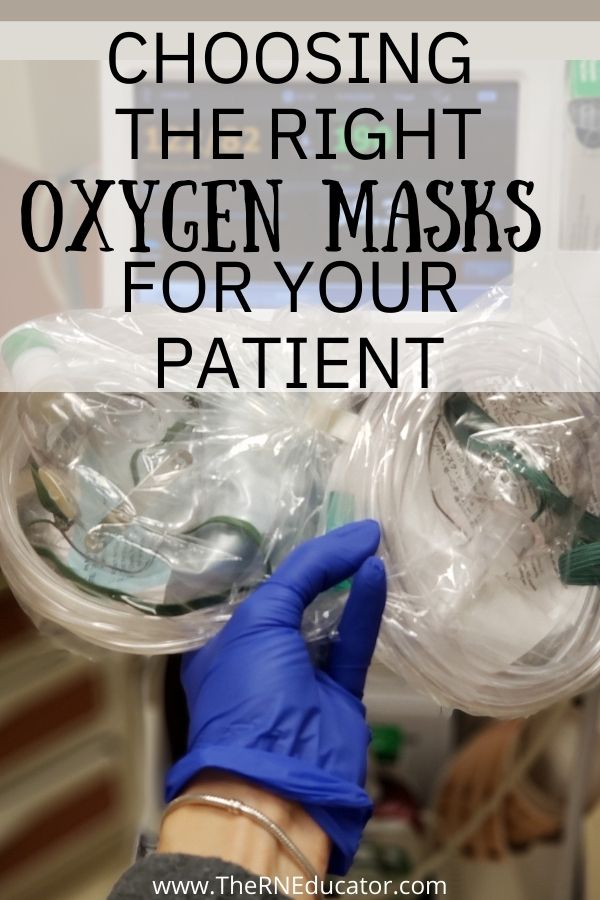Choosing the Right Oxygen Mask for Your Patient

As a nursing student you are probably learning all about oxygen masks and their uses. As a new nurse, you have probably forgotten some of this information and need a refresher. Let’s face it, it’s nearly impossible to remember everything. I’m here to go over all things oxygen masks, when to use them, benefits of each, and a few tips and tricks that will help you along the way. Ready to get started? Let’s go.
Nasal Cannula
Delivers: FiO2- 24% – 44%, Flow rate- 1 to 6L/min.
Let’s start with the most basic mask of all. Meet the Nasal Cannula. The Nasal Cannula is a low-flow oxygen delivery mask. It has two prongs that are inserted into the nostrils which deliver oxygen to the patient. A nasal cannula is probably the simplest and most comfortable oxygen delivery device and is usually well tolerated. The patient is able to talk and eat easily.
However, not all patients are a fan of this type of oxygen delivery system. Pediatric patients tend to hate the nasal cannula since they don’t like prongs in their nose. Aside from this, they don’t seem to like the idea of a tube wrapped around their face. If they give you lots of trouble (constantly pulling it down and removing the oxygen) you may have to resort to a simple mask or a blow-by (holding a mask delivering oxygen slightly away from the patient’s face).
Simple Face Mask
Delivers: FiO2- 35% to 50%, Flow rate: 6 to 12L/min
Unlike the nasal cannula, a simple face mask is placed over your patient’s nose and mouth. You use this mask when a patient needs a minimum of 6L/min to ensure removal of exhaled CO2 (which is what the holes on the side of the mask do). Do not use a simple mask with flow rates lower than 6L/min.
A simple face mask is easy to apply and depending on the patient can be more comfortable. This is also a great alternative for patient’s who are “mouth breathers” at night since a nasal cannula won’t give them the full oxygen they need.
Non-Rebreather Mask
Delivers: FiO2- 80% to 95%, Flow rates- 10 to 15L/min
The non-rebreather also covers the patient’s nose and mouth and is still a low-oxygen delivery device. However, the difference with this mask is that it has an attached reservoir bag that helps deliver the highest O2 concentration possible. The non-rebreather is also different than other masks in that is primarily used in emergency situations.
The masks has a one way valve over the reservoir bag, known as the reservoir valve. This allows the patient to inhale the maximum oxygen possible. There are exhalation openings on the side which are covered with flaps to prevent any room air from entering your patient’s mask while still allowing exhaled air to escape. When these flaps are removed the mask coverts to a partial rebreather mask. Always ensure your patient’s reservoir bag is inflated 2/3 full prior to placing the mask on your patient and during oxygen therapy.
Non-rebreathers are not meant for long-term oxygen therapy use. This is only used for emergency situations until further respiratory management is decided (ventilator, Bipap, etc…). Keep in mind, 100% oxygen for long periods of time can cause oxidative stress or oxygen toxicity.
Partial Rebreather Mask
Delivers: FiO2- 60% to 70%, Flow rates- 6 to 11/min
The partial rebreather mask looks very similar to a non-rebreather mask but has a two-way valve above the reservoir bag and the exhalation ports on the side of the mask are uncovered allowing room air to come into the mask. Unlike the non-rebreather, this two-way valve allows for some of the patient’s exhaled breath to return into the reservoir bag. This means the oxygen within the reservoir bag is diluted. This dilution inhibits the ability to deliver high oxygen concentration as the non-rebreather does. Hence the name “partial rebreather”.
This masks can also be used during emergency situations depending on how much oxygen the patient needs and patient condition. However, it is not to be used for long period of time.
Venturi Mask
Delivery: FiO2- 24% to 50%, Flow rate- 4 to 12L/min
The Venturi Mask is one of the only high-flow oxygen delivery devices other than the high-flow nasal cannula. Like the other face masks, it also fully covers the nose and mouth. It is used mostly in emergency situations or in patients who have chronic lung disease. This is because it delivers the most precise humidified oxygen concentrations. The delivery of oxygen in a Venturi mask is distributed via different size adapters. These adapters control the amount of flow rate and FiO2 released to the patient.
Eventually providers will slowly wean your patient off this device or switch you to a more effective device such as high-flow nasal cannula, BiPap, CPaP or even a ventilator if there is no improvement.
Nursing Considerations
Skin breakdown
Due to the the nasal cannula wrapping around a patient’s face you do have to keep in mind the possibility of skin breakdown. Anything that is pressed against patient skin for an extended period of time can lead to this. You can prevent this by adding a skin barrier directly to the area where the tube applies most pressure (usually around the cheek bones).
Oxygen can also easily dry out mucous membranes therefore, as a nurse you must ensure your patient’s nares aren’t irritated or having breakdown. You can prevent this by using a water-soluble gel around the nares and applying humidified oxygen for flow rates greater than 4L/min. However, keep in mind, just how oxygen can dry out the nares, humidified oxygen can cause skin breakdown due to the moist environment.
Claustrophobic patients
Keep an eye on these patients as they may have difficulty tolerating a face mask. This can make them more agitated and increase work of breathing.
Patients on aspiration precautions
Any face mask can put patients at high risk for aspiration or airway obstruction. Small children who may also be experiencing emesis (vomiting) can have a high risk of aspiration as well. Make sure to keep an eye out when these diagnosis or precautions are present in your patient.
Talking, eating and drinking limitations
Talking, eating and drinking may be impaired without removal of mask. If the patient is not NPO, the nurse may have to temporarily switch the patient to a nasal cannula at these times. However, the nurse is also responsible for ensuring the patient is receiving the necessary oxygen to maintain an appropriate and safe oxygen level.
Ensure masks are intact and functional
Always make sure all parts of your oxygen delivery system are intact and functional. This means ordered humidification is working, masks with valves and flaps are intact and working properly, masks with reservoir bags should be properly inflated.
Verify the FiO2 and flow rate
Always make sure the flow rate and FiO2 is accurate in comparison to the patient’s order. Having an incorrect flow rate and FiO2 not only can cause detrimental delays on your patient’s journey to recovery but can also lead to patient harm or further damage. A patient who needs oxygen and is not receiving the adequate amount can easily go into respiratory failure the same way a patient receiving too much oxygen for a long of a period of time can develop oxygen toxicity.
Well, I hope you found this information helpful and can apply it to your nursing clinicals or practice. Always make sure to prioritize the safety of your patients by assessing, assessing, assessing. As a nurse you can assess the need of oxygen on your patient, how long your patient has been on oxygen therapy, any possible or potential skin breakdown and accurate flow rate, FiO2 and mask. Soon you will be the ones teaching others all about face masks.
Now it’s time to test your knowledge & put your nursing caps on.
What emergency situation requires the need for a non-rebreather mask?
Comment your answer below.
’till next time,
The RN Educator

Share this:
Related Posts
What’s in a Pediatric Crash Cart? Nursing Students read NOW!
A pediatric crash cart is a mobile unit containing essential equipment and medications required for…
Share this:
How to Become a Confident Nurse
If you are anything like me, and let’s face it (like every nurse…



